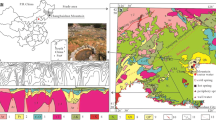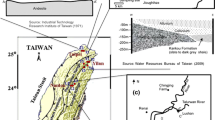Abstract
Rehai, a high-temperature hydrothermal system located in the southern part of the Tengchong volcanic geothermal area of Yunnan Province, is characterized by intensive hydrothermal activities. The hot springs at Rehai that have been sampled so far are Na-HCO3-Cl or Na-HCO3 springs except for the one at Diretiyanqu (experience geothermal area) which is an acid sulfate spring. As typical characteristic solution constituents in high-temperature hydrothermal systems with magma as heat source, Cl, B and As in the Rehai geothermal waters originate mainly from the addition of magmatic fluid. However, both the mixing of magmatic fluid and the dissolution of reservoir hostrocks contribute to the enrichment of fluoride in the Rehai geothermal waters, although their fluoride concentrations are primarily controlled by the solubility of fluorite as indicated by a clear negative relation between solution fluoride and calcium concentrations. The much higher concentration of SO4 2− in the Diretiyanqu Spring as compared to the other springs outcrop** at Rehai implies a quite different geochemical genesis for this spring. The H2S-rich vapor, separated from the deep geothermal fluid during boiling process (i.e., adiabatic cooling), can ascend to shallow aquifers where it is mixed with cold groundwaters and oxidized. Acid sulfate-rich hot springs are generally formed in this manner although only one spring of this type has been sampled during the field investigation of this study.
Similar content being viewed by others
References Cited
Appelo, C. A. J., Postma, D., 1996. Geochemistry Groundwater and Pollution. Balkema, Rotterdam
Arnórsson, S., Andresdottir, A., 1995. Processes Controlling the Distribution of Boron and Chlorine in Natural Waters in Iceland. Geochimica et Cosmochimica Acta, 59: 4125–4146
Baba, A., Sözbilir, H., 2012. Source of Arsenic Based on Geological and Hydrogeochemical Properties of Geothermal Systems in Western Turkey. Chemical Geology, 334: 364–377
Bai, D. H., Liao, Z. J., Zhao, G. Z., et al., 1994. The Inference of Magmatic Heat-Source beneath the Rehai (Hot Sea) Field of Tengchong from the Result of Magnetotelluric Sounding. Chinese Science Bulletin, 39: 572–577
Ballantyne, J. M., Moore, J. N., 1988. Arsenic Geochemistry in Geothermal Systems. Geochimica et Cosmochimica Acta, 52: 475–483
Browne, P., Rodgers, K. A., 2006. Occurrence and Significance of Anomalous Chloride Waters at the Orakei Korako Geothermal Field, Taupo Volcanic Zone, New Zealand. Geothermics, 35(3): 211–220
Capaccioni, B., Aguilera, F., Tassi, F., et al., 2011. Geochemical and Isotopic Evidences of Magmatic Inputs in the Hydrothermal Reservoir Feeding the Fumarolic Discharges of Tacora Volcano (Northern Chile). Journal of Volcanology and Geothermal Research, 208(3/4): 77–85
Dotsika, E., Poutoukis, D., Michelot, J. L., et al., 2006. Stable Isotope and Chloride, Boron Study for Tracing Sources of Boron Contamination in Groundwater: Boron Contents in Fresh and Thermal Water in Different Areas in Greece. Water Air and Soil Pollution, 174: 19–32
Du, J. G., Liu, C. Q., Fu, B. H., et al., 2005. Variations of Geothermometry and Chemical-Isotopic Compositions of Hot Spring Fluids in the Rehai Geothermal Field, Southwestern China. Journal of Volcanology and Geothermal Research, 142: 243–261
Gao, Q. W., Fan, S. Q., 1992. Geochemical Characteristics of Geothermal Fluid in the Active Area of the Tengchong Modern Volcanoes. J. **’an College Geol., 14(3): 40–44 (in Chinese)
Giggenbach, W. F., Guern, F. L., 1976. The Chemistry of Magmatic Gases from Erta’Ale, Ethiopia. Geochimica et Cosmochimica Acta, 40(1): 25–30
Guo, Q. H., 2012. Hydrogeochemistry of High-Temperature Geothermal Systems in China: A Review. Applied Geochemistry, 27: 1887–1898
Guo, Q. H., Wang, Y. X., 2012. Geochemistry of Hot Springs in the Tengchong Hydrothermal Areas, Southwestern China. Journal of Volcanology and Geothermal Research, 215: 61–73
Guo, Q. H., Wang, Y. X., Liu, W., 2009. Hydrogeochemistry and Environmental Impact of Geothermal Waters from Yangyi of Tibet, China. Journal of Volcanology and Geothermal Research, 180(1): 9–20
Guo, Q. H., Wang, Y. X., Liu, H., 2007. Major Hydrogeochemical Processes in the Two Reservoirs of the Yangba**g Geothermal Field. Journal of Volcanology and Geothermal Research, 166: 255–268
Gunnarsson, I., Arnórsson, S., 2005. Impact of Silica Scaling on the Efficiency of Heat Extraction from High-Temperature Geothermal Fluids. Geothermics, 34(3): 320–329
Jiang, C. S., Zhou, R. Q., Yao, X. Z., 1998. Fault Structure of Tengchong Volcano. J. Seismol. Res., 21(4): 330–336 (in Chinese with English Abstract)
Liao, Z. J., Zhao, P., 1999. Yunnan-Tibet Geothermal Belt-Geothermal Resources and Case Histories. Science Press, Be**g (in Chinese with English Abstract)
Liao, Z. J., Shen, M. Z., Guo, G. Y., 1991. Characteristics of the Geothermal Reservoir in the Rehai (Hot Sea) Field in Tengchong County, Yunnan Province. Acta Geol. Sin., 65: 73–85 (in Chinese with English Abatract)
Nordstrom, D. K., McCleskey, R. B., Ball, J. W., 2009. Sulfur Geochemistry of Hydrothermal Waters in Yellowstone National Park: IV Acid-Sulfate Waters. Applied Geochemistry, 24: 191–207
Peng, X. T., Jones, B., 2012. Rapid Precipitation of Silica (Opal-A) Disguises Evidence of Biogenicity in High-Temperature Geothermal Deposits: Case Study from Dagunguo Hot Spring, China. Sedimentary Geology, 257: 45–62
Rudnick, J., Guo, H., Jasnow, D., 1988. Finite-Size Scaling and the Renormalization Group. Current Physics-Sources and Comments, 2: 47–67
Smedley, P. L., Kinniburgh, D. G., 2002. A Review of the Source, Behaviour and Distribution of Arsenic in Natural Waters. Applied Geochemistry, 17(5): 517–568
Shangguan, Z. G., Zhao, C. P., Li, H. Z., et al., 2005. Evolution of Hydrothermal Explosions at Rehai Geothermal Field, Tengchong Volcanic Region, China. Geothermics, 34: 518–526
Tong, W., Zhang, M. T., 1989. Geothermics in Tengchong. Science Press, Be**g (in Chinese with English Abstract)
Vala Ragnarsdóttir, K., Walther, J. V., 1983. Pressure Sensitive “Silica Geothermometer” Determined from Quartz Solubility Experiments at 250 °C. Geochimica et Cosmochimica Acta, 47(5): 941–946
Verma, P. S., Santoyo, E., 1997. New Improved Equations for Na/K, Na/Li and SiO2 Geothermometers by Outlier Detec tion and Rejiection. Journal of Volcanology and Geothermal Research, 79: 9–23
Wang, S. F., Pang, Z. H., Liu, J. R., et al., 2013. Origin and Evolution Characteristics of Geothermal Water in the Niutuozhen Geothermal Field, North China Plain. Journal of Earth Science, 24(6): 891–902
Wei, H., Sparks, R. S. J., Liu, R., et al., 2003. Three Active Volcanoes in China and Their Hazards. J. Asian Earth Sci., 21: 515–526
WHO, 1993. Guidelines for Drinking-water Quality, http://www.who.int/watersanitationhealth/dwq/gdwq2v1/en/index.html
White, D. E., Brannock, W. W., Murata, K. J., 1956. Silica in Hot-Spring Waters. Geochimica et Cosmochimica Acta, 10: 27–59
Wu, G. J., Hu, X. Y., Huo, G. P., et al., 2012. Geophysical Exploration for Geothermal Resources: An Application of MT and CSAMT in Jiangxia, Wuhan, China. Journal of Earth Science, 23(5): 757–767
Xu, Q., Li, C. H., Wang, J., et al., 1997. Geothermal Resources in Tengchong Region, Yunnan Province. Geol. Geochem, 4: 77–84 (in Chinese)
Yan, K., Wan, D. B., 1998. Study on Mechanism and Chemical Characteristics of Hot Spring Swarms in Tengchong Hot Sea. J. Seismol. Res., 21: 388–396 (in Chinese with English Abstract)
Zhang, G. P., Liu, C. Q., Liu, H., et al., 2008. Geochemistry of the Rehai and Ruidian Geothermal Waters, Yunnan Province, China. Geothermics, 37: 73–83
Zhang, Z. F., Liu, S. B., Zhao, F. S., 1987. Geochemistry of Thermal Waters in the Tengchong Volcanic Geothermal Area, West Yunnan Province, China. Geothermics, 16: 169–179
Zhao, P., Liao, Z. J., Guo, G. Y., et al., 1996. Steam Quantitative Analysis and Its Implication in the Rehai Geothermal Field, Tengchong. Chinese Science Bulletin, 41: 501–505
Author information
Authors and Affiliations
Corresponding author
Rights and permissions
About this article
Cite this article
Liu, M., Guo, Q., Zhang, X. et al. Characteristic solutes in geothermal water from the Rehai hydrothermal system, Southwestern China. J. Earth Sci. 26, 140–148 (2015). https://doi.org/10.1007/s12583-015-0600-5
Received:
Accepted:
Published:
Issue Date:
DOI: https://doi.org/10.1007/s12583-015-0600-5




